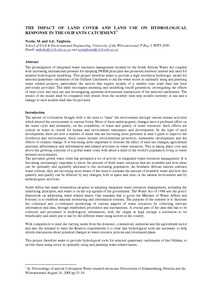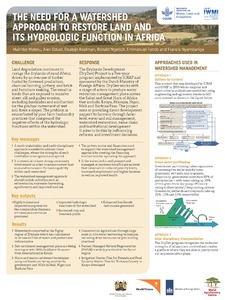Testing criteria and indicators for the sustainable management of forests: phase 1. Final Report
This report documents the conduct of the first field tests of criteria and indicators (C&I) at the forest management unit level. Interdisciplinary and international teams of five persons conducted tests of five sets of C&I in four countries (Germany, Indonesia, Brazil, and Cote d’Ivoire). This report provides a description of the methods used, a thorough analysis of the findings, a combined generic template of C&I dealing with production forestry, policy, social and ecological issues, based on the groups’ results.
The Chinyanja triangle in the Zambezi River Basin, southern Africa: status of, and prospects for, agriculture, natural resources management and rural development
The Chinyanja Triangle (CT) is an area inside the Zambezi
River Basin, inhabited by Chinyanja-speaking people
sharing a similar history, language and culture across
the dryland systems of the eastern province of Zambia,
southern and central regions of Malawi and Tete Province
of Mozambique. Chiefs and Chiefdoms play a critical role
in decision making and influencing social relationships. The
Zambezi River, which originates in the Kalene Hills in Zambia
is joined by ten big tributaries from six countries, and is
The domestic market for small-scale chainsaw milling in Cameroon: present situation, opportunities and challenges
In 1994 Cameroon adopted a new forest law that focussed on the large-scale, export-oriented industrial forest sector while timber produced through small-scale logging for the domestic market was ignored, even in official statistics, and is generally produced without a valid permit. As Cameroon prepares to implement the Voluntary Partnership Agreement (VPA) it recently signed with the European Union, promising a legal framework for all national timber production, this occasional paper presents a quantitative and qualitative evaluation of the country’s domestic timber market.
The evolution of swidden fallow secondary forests in Asia
Swidden agriculture in tropical Asia is a diverse practice, making it difficult to draw general conclusions on trends of the development of swidden fallow secondary forests (SFSF). There is, however, sufficient evidence to recognise trends of a gradual intensification often through the incorporation of extensive tree crop production in SFSF, or a direct conversion to intensive tree cash cropping. Factors contributing to the changes include emerging markets for cash crops or timber and pulp wood production, government policies and development projects, fire, and population pressures.
The Evolving Farming and Pastoral Landscapes in Ethiopia: A Farming System Framework for Investment Planning and Priority Setting
La genèse des politiques publiques foncières comme mode d’action de l’État ougandais sous le leadership de Y. Museveni
The impact of land cover and land use on hydrological response in the Olifants Catchment
The impact of government policies on land use in northern Vietnam: an institutional approach for understanding farmer decisions
This report identifies the driving forces for reforestation in three villages of Northern Vietnam. Using an institutional analysis focused on the rules governing upland access and use, the authors assess the relative impact of state policies (reforestation programs and forestland allocation) on land use change. Findings show that the latter are indirectly responsible for reforestation, but not because of the incentives they provided. Instead, they disrupted the local rules governing annual crop cultivation and grazing activities leading to the end of annual cropping.
The role of biochar in ameliorating disturbed soils and sequestering soil carbon in tropical agricultural production systems
Agricultural soils in the tropics have undergone significant declines in their native carbon stock through the long-term use of extractive farming practices. However, these soils have significant capacity to sequester CO2 through the implementation of improved land management practices. This paper reviews the published and grey literature related to the influence of improved land management practices on soil carbon stock in the tropics.



